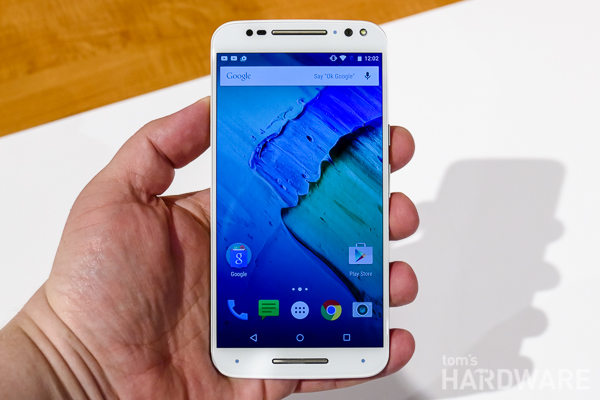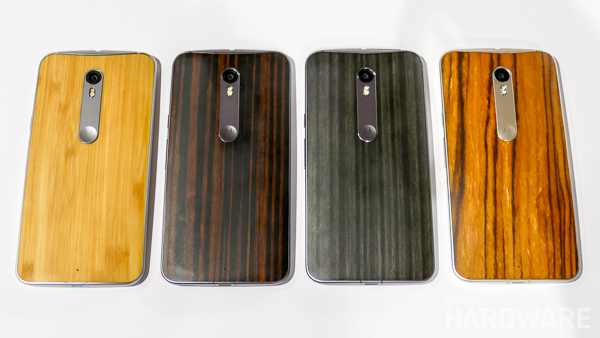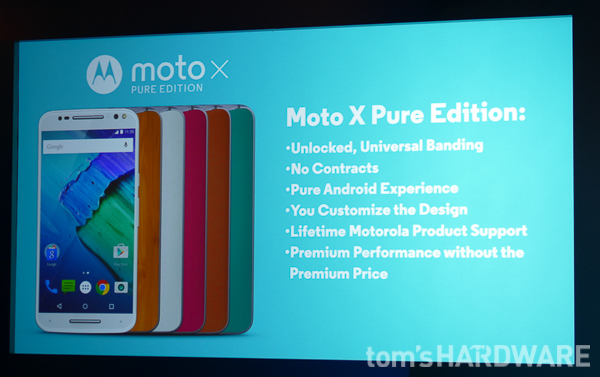Hands-On Video Of The Motorola Moto X Style/Pure Edition Smartphone
Motorola announced three new phones: the Moto X Style, the Moto X Play and Moto G (3rd Gen). The Moto X Style is the premium device in its new lineup and the one we are most excited about. It's coming out in September, so we only had a small window of time at the event to go hands-on with it. You can read our impressions and watch our hands-on video below.
One point of clarification that does need to be made is the naming convention of this new Moto X. The phone will be known as the "Moto X Style" in all the markets it will be released in apart from the U.S. Here, it will be called the "Moto X Pure Edition" and will only be sold unlocked by Motorola, Amazon and Best Buy. The reason for this name is that it offers an (almost) Pure Android experience in the same way that Google's Nexus series of devices do.
While we were looking at the Pure Edition specifically, our hands-on is relevant to the Moto X Style, too, because it is an identical phone available through a different sales model. (This is not to be confused with the Moto X Play, which is a different device entirely.)
Hardware Specifications
| SoC | Qualcomm Snapdragon 808 1.8 GHz 64-bit hexa-core processor (2 x Cortex-A57 and 4 x Cortex-A53) with Adreno 418 GPU |
|---|---|
| Display | 5.7-inch Quad HD TFT LCD display (2560 x 1440, 520ppi) with Gorilla Glass 3 |
| Memory | 16/32/64GB eMMC ROM, 3GB LPDDR3 RAM / microSD slot |
| Camera | Rear: 21MP with f/2.0 aperture & 1/2.4" Sony Exmor RS IMX230 sensor / PDAF / Dual LED CCT flashFront: 5MP with 87-degree wide angle lens and flash |
| Battery | 3,000 mAh (non-removable), Turbo Charging |
| Operating System | Android 5.1.1 Lollipop |
| Size & Weight | 153.9 x 76.2 x 6.1 to 11.06 mm, 179g |
| Network | 4G / LTE cat. 6 / HSPA+ (LTE Bands 1, 2, 3, 4, 5, 7, 8, 12, 13, 17, 25, 26, 38, 41)Nano SIM |
| Connectivity | Wi-Fi 802.11 a, b, g, n, ac / Bluetooth 4.1LE / NFC / USB 2.0 |
| Audio | Front-facing stereo speakers |
| Colors | Black, White and Bamboo standard. Customizable on Moto Maker. |
| Carriers | U.S.: Moto X Pure Edition unlocked from Motorola, Amazon and Best BuyRest of World: Moto X Style TBA |
| Pricing | Starting at $400 |
It is interesting that the specs of the Moto X Pure Edition are very similar to the LG G4, which uses the same Snapdragon 808 SoC, 3 GB of RAM, QHD display and 3,000 mAh battery. That means you should expect similar performance from the Moto X, which is very good. While we haven't finished our review of the G4 yet, we have spent quite a bit of time with it, and have been impressed by the Snapdragon 808, which bodes well for the Moto X Pure Edition. It is also good to see that Motorola hasn't ignored the needs of many Android phone users by including a microSD slot.
Another impressive feature is the amount of LTE bands that the new Moto X supports. Motorola said that it has "universal" LTE support for all U.S. carriers, including Verizon and Sprint, which is impressive. There are 14 bands listed, and the X supports Category 6 LTE speeds of up to 300 Mbps. This means that not only will it work through the U.S., but if you are a frequent traveler, you should be able to get LTE connectivity most anywhere in the world.
We are a little disappointed to see that Motorola did not include a fingerprint sensor. Although its usefulness would be limited at present, by the time the phone is released in September, Google's new Android Pay mobile payment solution should be launched. Having a fingerprint reader to authenticate when using Pay is an important feature that the Moto X is missing.
The combination of a 3,000 mAh screen, Snapdragon 808 SoC and QHD display means that the Moto X's battery life should be similar to the LG G4's. Which is to say good, but not great.
Get Tom's Hardware's best news and in-depth reviews, straight to your inbox.
The Moto X uses Motorola's TurboPower technology, which is Qualcomm's Quick Charge 2.0 rapid charging tech. This has already been available on other Motorola phones using the optional 15 W Turbo Charger. We were told that the Moto X Pure Edition will come with an even faster charging 25 W charger in the box. We are not sure if the Style version of this phone will come with the same. This faster charger allows the Moto X to get 50 percent more power in 15 minutes than competing fast charging solutions such as Samsung's Adaptive Fast Charging.
Hands-On Video
Design
The Moto X Pure Edition contains the same design DNA as previous Motorola phones such as the Moto X (2014) and Nexus 6. It has the same metal sides and curved non-removable back. One thing that has changed is the surround for the camera, and all of the 2015 Motorola phones including the Moto X Play and Moto G have a metal "bar" that runs down the middle of the back below the camera. A nice touch is the return of the Motorola logo dimple that becomes a natural, comfortable resting place for your index finger when holding the phone.
Up top, we find the headphone jack and the combination slot for the Nano SIM and microSD card.
On the bottom is the microUSB 2.0 port. It is a little disappointing that the new Moto X doesn't use a USB Type-C port. This reversible port is the connector of the future, and it will soon become the standard for all smartphones, and we'd wish Motorola had been a little more forward-thinking.
The default back finish is new this year and is what Motorola calls "coated silicone rubber" (CSR). It has a nice, smooth touch matte finish and does not show fingerprints. You can also get the Moto X with an optional wood or leather back. It has a water-repellent nano-coating -- which is not water-resistant, mind you. The fine print on Motorola's site specifically says, "Not designed to be submersed in water, or exposed to pressurized water, or other liquids; Not waterproof."
Despite having a huge 5.7-inch screen, the Moto X is still reasonably compact for a big phone, having a screen-to-body ratio of 76 percent. This is substantially higher than the iPhone 6 Plus' 68 percent, as well as the Galaxy S6's 71 percent and LG G4's 72.5 percent. In fact, it is one of the highest of any smartphone. So despite having a bigger screen, the Moto X is still physically overall a smaller device than the iPhone 6 Plus.
Customization
Motorola's phones are the most customizable on the market today. Using its Moto Maker website, you can change the color and material of the back, and choose from three different colors for the metal sides. You can also customize the color of the metal accents around the camera and the speakers.
There are 10 different CSR color choices, many of which you can see in the image above. The metal accents are available in seven different colors. The choice of side metal color is determined by your color choice for the front lens, either black or white.
The Moto X can also be customized with either a wooden or leather back (for an extra cost). There are four wood choices – bamboo, walnut, ebony and charcoal ash (which you can see above on the right). The leather used is Saffiano leather sourced from Horween, "one of the finest U.S. leather companies." Saffiano leather has a hard texture finish that is scratch-resistant and much more durable that regular leather. One of the negatives of the leather used on last year's Moto X is that it soon got quite scuffed up with use. The leather color options are red, black and natural (shown above) and cognac (not shown).
If you buy the Moto X Pure Edition from Amazon or Best Buy, you will not be able to customize it. Those sellers will have it in white with champagne gold metal accents, bamboo with silver metal accents, and black with dark gray metal accents.
Camera
One of the biggest weaknesses of previous Motorola phones were their cameras. For the 2015 models, Motorola went back to the drawing board and stated that its new devices will have best in class cameras. While we haven't (of course) been able to verify this yet by testing the Moto X's camera, its specs do at least look great on paper. The Moto X Pure Edition uses the new 21MP Sony Exmor RS IMX230 sensor. This is a big 1/2.4" stacked CMOS sensor that has phase detect autofocus (PDAF) with 192 focus points. Its size means that its pixel size shouldn't be too small, despite the megapixel count, allowing for decent low light performance. This sensor can shoot 4K video in HDR, too, which is a nice bonus.
Motorola has combined the sensor with an f/2.0 lens with a blue glass IR filter that helps reduce lens flare and chromatic aberrations. It has a dual LED CCT (color correlated temperature) flash for better color balance when shooting with the flash. Unfortunately, the Motorola camera app does not have a full manual mode – you can adjust the exposure levels, but not ISO, shutter speed and so on. You should, however, be able to download third-party camera apps that leverage Google's Camera2 API to get full control of the camera.
Image quality with this sensor should be very good, and DXOMark has already tested it and rated it higher than every other smartphone apart from the Note 4 and Galaxy S6. This is a big improvement over the camera in the previous Moto X. However, this rating didn't take into account the LG G4, which in my opinion has the best camera of any phone on the market. It will be hard for Motorola to beat the G4's performance.
The front-facing camera is 5MP and has an 87-degree wide angle with front facing flash. The "double twist the phone to start the camera" gesture has returned on, and now you can double twist again to activate the front camera instead.
Software
The Moto X Pure Edition runs an almost stock version of Android 5.1.1 Lollipop. Motorola has included its own camera and gallery apps and added a suite of its value-add features, but other than that, this is stock Android in every other way. Also, because this is going to be sold unlocked without any carrier involvement, there won't be any useless bloatware or carrier apps.
The standard suite of Motorola apps included are Moto Assist, Moto Voice, Moto Display and Moto Actions. These are the same as last year's Moto X, and they do add some useful features to the smartphone experience, such as improved voice control. We are not sure if there are any major changes or improvements to the versions installed on the Moto X, as we didn't have too much time to test out the software.
One area of concern though is the Moto Display feature. This displays notifications that appear while the screen is off. Moto Display is activated by picking the Moto X up or reaching your hand towards the screen. Previous Motorola phones had AMOLED displays, where these minimal white notifications showed up on the powered-down screen and only the pixels needed to display the white text were lit.
This meant that there was minimal impact to battery life. However, because the new Moto X now uses a TFT LCD screen, the entire screen now needs to turn on to show the notifications. This is because of the difference in the way LCD and AMOLED screens display black pixels. Now, if Moto Display is turned on in the Moto X Pure Edition, there will be a much more significant impact on battery life.
Availability And Pricing
As mentioned, the Pure Edition of the new Moto X will be the only model available in the U.S. In other markets, it will be sold as the Moto X Style, possibly unlocked and by carriers, though Motorola did not provide any details.
The Pure Edition will be sold online by Motorola (where it can be customized), Amazon, and Best Buy. It will also be sold in Best Buy retail stores. Pricing starts at $400 for the 16 GB model, with an extra $50 for each additional level of storage (32 GB or 64 GB). This makes the Moto X an incredible value, because unlike some competing budget flagships, there seem to be no compromises (like the removal of NFC as on the OnePlus 2). However, the aforementioned lack of a fingerprint reader will impact it when Google Pay launches later this year.
The Pure Edition even fills the need for a stock Android phone to replace the discontinued Nexus 5, for those who find the Nexus 6 too big (though in all honesty, the new Moto X isn't that much smaller). I'd even see it as a viable competitor for the Note 4/5 for those who don't have any need for the S Pen. I own a Note 4 and love its size, but really rarely, if ever, do I use the S Pen, and I would love to replace it with a similarly-sized premium device running stock Android.
The Motorola Moto X Pure Edition will be available in September.
Alex Davies is an Associate Contributing Writer for Tom's Hardware, covering Smartphones, Tablets, and Virtual Reality. You can follow him on Twitter. Follow Tom's Hardware on Twitter, Facebook, and Google+.
-
Didenko Does the "Pure Experience" mean that OS updates will come directly from Google (like on the Nexus line) or that Motorola will still be the gate-keeper?Reply -
MobileEditor ReplyDoes the "Pure Experience" mean that OS updates will come directly from Google (like on the Nexus line) or that Motorola will still be the gate-keeper?
The updates come from Motorola, since the firmware still needs to include device specific drivers and the few custom Motorola apps.
- Matt Humrick, Mobile Editor, Tom's Hardware -
Didenko Replythe firmware still needs to include device specific drivers and the few custom Motorola apps
Device drivers make sense, thanks for pointing it out. The apps though better be updated via store. Oh, well... -
coupe To a lot of people, getting the phone out of contract for $400 doesn't matter since a lot of people get phones for $200 under contract. So they will see this phone as more expensive.Reply
Motorola should work with phone companies to subsidize the cost. -
scolaner ReplyTo a lot of people, getting the phone out of contract for $400 doesn't matter since a lot of people get phones for $200 under contract. So they will see this phone as more expensive.
Motorola should work with phone companies to subsidize the cost.
Interesting...I partially agree with you on the price issue. I mean, on one hand, $400 is not bad at all for a flagship killer...on the other hand, $400 is a lot of money. OnePlus 2 is cheaper, Asus ZenPhone 2 is cheaper, Lumia 640/640 XL are cheaper...but still very nice phones.
I don't want Motorola (or anyone) to start playing the subsidizing game, though. That was bad news before, it will be bad news again. Just let me buy my device for what it costs.











